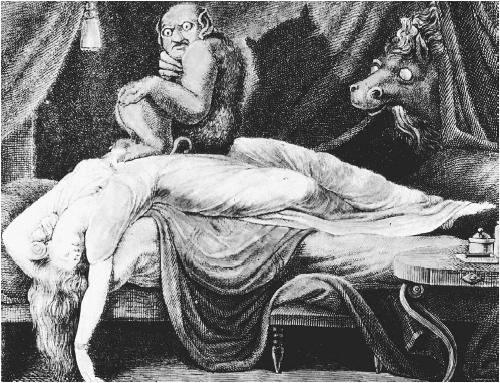Dreams
Nightmares
A nightmare differs considerably from a frightening dream. The terror of a nightmare is more intense and does not present an image or a dream sequence. Dreamers in the throes of a nightmare cry out while in deep sleep. They sweat, have difficulty in breathing, and often appear as if paralyzed.
In 1968 Dr. R. J. Broughton compiled considerable evidence that indicates that bed-wetting, sleepwalking, and nightmares occur during periods of deep sleep rather than during periods of dreaming, as the layperson often assumes. Bed-wetting is common among unstable individuals, and the sleepwalker, in about 25 percent of the cases, is also a bed-wetter. Dream researcher Dr. Stanley Krippner agrees that nightmares, bed-wetting, and sleepwalking rarely coincide with dream periods.
Psychiatrist Ernest Hartmann of Tufts University believes that the nightmares of people who seem physically healthy but who regularly suffer from "bad dreams" are reflecting their personalities rather than a traumatic past or a present struggle with health problems. Hartmann found evidence of "thin boundaries" in people prone to recurrent nightmares. In his assessment they were men and women who tended to be more open and sensitive than the average. They were, he discovered, people with a tendency to become quickly and deeply involved in relationships with other individuals. At the same time, paradoxically, they also tended to be "loners," people who did not identify strongly with groups of any kind.
Hartmann developed a 138-item "Boundary Questionnaire" that he administered to more than a thousand people, including a wide range of students, nightmare sufferers, and naval officers. The findings supported earlier studies that suggested that many of the men and women who endure nightmares are artistic or otherwise creative people. Naval officers, not surprisingly, most often turned up on the opposite end of the scale with rather "thick boundaries." Hartmann speculates that "boundary thickness" may reflect a basic organizational pattern of the brain—one that is genetically determined or established early in life. The general openness of "thin-boundaried" people may predispose them to creativity, but it also binds them to a childlike vulnerability that leaves them at the mercy of the night creatures that go "bump" in the darkness.
Nightmares, then, just might be the price that some otherwise healthy and untroubled people pay for their sensitivity and creativity. The nightmare may work out the vulnerability, Hartmann states, especially if the sufferer learns to maneuver the frightening dream from a place of vulnerability to a place of control.

On October 2, 2001, clinical psychologist Alan Siegel, editor of Dream Time magazine, told Mike Conklin, reporter for the Chicago Tribune, that the people of the United States had entered a "national epidemic of nightmares" brought on by the destruction of the World Trade Center on September 11. "Nightmares are a cardinal symptom of something traumatic in [One's] life," Siegel said. "In this case, we've lost our sense of security, and this is something more traumatic than most Americans have really experienced before."
Dr. Michael Friedman, a sleep specialist at Rush-Presbyterian St. Luke's Medical Center in Chicago, agreed that there was no question that they had begun treating many patients with sleep problems and nightmares related to the incidents of that terrible event. Deirdre Barrett, a psychology professor at Harvard Medical Center who supervised counselors at Boston's Logan Airport following the hijackings of the jets that crashed into the Twin Towers, cautioned that in some cases it might be six months or a year before certain people would begin having traumatic dreams of the series of events that occurred on September 11, 2001.
Siegel went on to explain that such nightmares should be considered the brain's natural means of dealing with the trauma, dispelling it through the subconscious while people are sleeping. Although people tend to think of nightmares as a kind of mental poison, Siegel said that, in reality, "they are a form of vaccine."

Comment about this article, ask questions, or add new information about this topic: